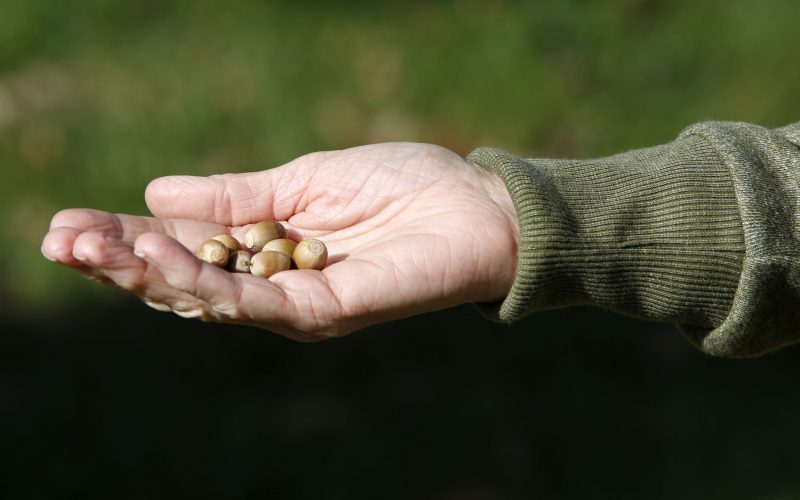Nature’s bounty literally falls from trees in autumn
AMANDA BANCROFT
Making Ripples

NWA Democrat-Gazette/DAVID GOTTSCHALK The hand of Kathryn Scherer, of Fayetteville, is visible holding acorns produced from a more than 150 year old White Oak Tree.
Nature’s garden has a lot of free produce falling from the sky at this time of year, and most people do not go to the trouble to eat it. Imagine a garden nobody had to cultivate, in which nobody felt like harvesting! It’s almost too good to be true. The only better scenario would be a scene from the 2009 animated film “Cloudy with a Chance of Meatballs.”
There’s a catch here, you might be thinking. If there is so much food just falling out of trees, why isn’t anybody harvesting it? Well, there used to be. Indigenous peoples in Northwest Arkansas had stockpiles of acorns for roasting, among many other things. European settlers for generations would collect persimmons, hickory nuts, blackberries and many other wild foods and think nothing of it. It was the norm. But it isn’t as easy to mechanize the processing of certain wild foods, and because of our private property laws, most people don’t have free access to forage areas anymore. It takes a lot longer to get fruit out of the pawpaw, compared to its counterpart, the banana, which once had gigantic seeds before humans “improved” it.
Hickory trees, if you have not met any yet, are nice friends to have, and they can live up to 500 years. The outer husk comes off easily without staining, but the shell is incredibly hard to crack open. Banging a hammer against the shell placed on a rock seems the preferred choice, and certain nutcrackers have worked for us.
Some say hickory is the highest calorie wild plant food in the United States. Nature offers several local varieties you might find along a rural roadside or urban park. The shagbark hickory’s namesake shaggy bark is the easiest to identify, and its nuts are the tastiest, with a buttery pecan flavor. Other local trees include the bitternut (said to be bitter) and the mockernut, which I think tastes divine! Use a book like “Trees of Arkansas,” or an image search online to become familiar with various hickory barks, leaves and nuts. Then go for a hike and see what you find!
You can eat hickory nuts raw by picking them right out of the shell, freeze them for long-term storage or keep them for a couple of months in a cool, dark place. But please be cautious if you or a member of your household has any nut allergies. Hickories are in the walnut family. When in doubt, leave it out.
If you’d like to try using hickory nuts in recipes and not just eating them raw or roasted, they are a fairly straightforward substitution for pecans. Since pecan trees are in the hickory tree genus, they’re closely related. Hickory is even used as a root stock for grafting pecan trees in orchards. Try replacing pecans with hickory nuts in buttery shortbread cookies, pecan pie or cakes.
Amanda Bancroft is a writer, artist, and naturalist building an off-grid cottage for land conservation on Mt. Kessler. She and her husband Ryan blog about their adventures and offer a solar-hosted online educational center on how to make a difference with everyday choices at: www.RipplesBlog.org.










